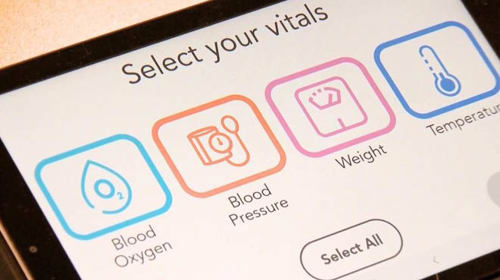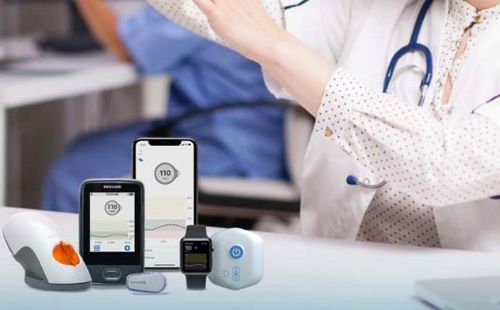The acquisition of data relating to vital signs - such as heart rate, breathing capacity, blood oxygen levels and temperature - is a fundamental part of providing appropriate healthcare to the public.
This can be used either as a precautionary tactic to uncover potential issues as they arise and then aid rapid diagnosis, or to assess the severity and subsequently control an existing medical complaint.
Traditionally, this type of monitoring has been carried out under supervision, often within a clinical environment. Times are changing, however, and this is leading to a new approach being taken in relation to these activities in which remote monitoring is now becoming an invaluable tool to the medical profession.
Several dynamics are driving the move away from clinically-based monitoring towards undertaking such work remotely. For those with long-term medical conditions, the emphasis is on improving quality of life. There are significant benefits in enabling people to remain in their own homes for longer, with medical interventions in hospitals or other facilities only being taken when absolutely necessary. Staying in familiar surroundings can reduce stress and anxiety, as well as reducing risk of infection or injury caused by vulnerable patients having to travel long distances to attend repeat appointments. Allied to this is the need to take the pressure off overloaded central health services and free up skilled staff and bed spaces for patients who genuinely require dedicated care.
Furthermore, people are in general terms becoming more health aware than they were in the past. Consequently, they want to have more involvement in controlling their own wellbeing. The ability to monitor their biorhythms conveniently and without hospital appointments is therefore highly attractive.
A shift in age demographics is also going to make remote monitoring more of a necessity in the future, as the world comes to terms with having an increasingly elderly population. According to the World Health Organisation (WHO), the percentage of people over 60 years old will have doubled by 2050, and the number of people over 80 will have tripled.
Having access to regularly updated information on health-related parameters, which are taken from the home environment, will play a key role in keeping older people healthy for longer. It can also contribute to individuals retaining independent living.

Sensing techniques
A series of sensing methodologies have emerged via which remote medical monitoring can be done. These offer the accuracy, simplicity of implementation and portability that such applications clearly mandate. Some of them are already established, while others are just starting to be explored.
Photo-plethysmography (PPG) - This is a straightforward and inexpensive optical technology via which non-invasive measurements may be taken. It is typically applied to patients’ fingertips, earlobes or wrists. LEDs emit light that is incident on the subject’s skin and then the accompanying photodiode measures changes in light intensity caused by blood volume or oxygen content. PPG can be utilised for measuring heart rate, respiratory rate (RR) and heart rate variance (HRV), as well as acting as a pulse oximeter to determine peripheral capillary oxygen saturation (SpO2). With the correct algorithms, it is also possible to use PPG for blood pressure measurements.
However, the downside of this technique is that it is known to be affected by body movement. This has been detrimental to its accuracy when applied in a wearable context. Advances in relation to the emitters and receivers, improved algorithms and better noise mitigation within the signal chain have been witnessed in recent years. These have all contributed to making PPG better suited to remote monitoring of vital signs.
Electrocardiogram (ECG) technology - This is a well-established means of detecting the electrical signals of the heart each time it beats. It is typically used to identify irregularities - such as arrhythmia, atrial fibrillation (which is a common cause of strokes) and cardiomyopathy. Traditional ECG machines were expensive and bulky, so these tests needed to be carried out in a hospital environment. While the testing itself normally lasted just a few minutes, the disruption for the patient could be considerable. Early attempts to evolve the technology for personal use included experimentation in developing a t-shirt that incorporated distributed ECG sensors.
Within the last decade, miniaturisation and the arrival of more energy-efficient sensors have led to this technology being successfully adapted for wearable usage (such as in smart watches and fitness bands). ECG readings can now be taken simply by maintaining contact with a smart portable device, usually through the finger. Wireless connectivity also makes it possible to share results remotely with qualified medical personnel located back at the clinic/hospital.
Temperature monitoring - Though often overlooked, this is a critical indicator of a patient’s state of health. The recent COVID pandemic was a prime example, and accelerated the need for accurate, non-contact temperature monitoring on a mass scale. At an individual level, small, medical-grade temperature sensors are already available for measuring surface skin temperature. Skin temperature data is then calibrated to estimate actual body temperature. This avoids the insertion of a thermometer and enables constant monitoring. Nevertheless, it must be acknowledged that there are still some obstacles to overcome. Ways to apply this type of sensor reliably inside the ear (via earbuds) are currently being investigated, as the skin temperature here is more stable and nearer to actual body temperature.
Electrochemical sensors - These can pick up certain biomarkers. There is potential here for them to help expedite cancer diagnoses, as well as better detection and control of conditions like diabetes. This technology is already deployed in fitness devices for sweat monitoring (as a general health indicator), and some success has been seen in the development of glucose monitoring devices paired to smartphone handsets. There are challenges that remain in other medical applications though. Among these are the ability to collect adequate sweat samples, the need to be able to detect multiple indicators with just one sensor (as no single analyte alone can provide a clear indicator of overall health), and lack of clinical data regarding the correlation between analyte levels in blood and analyte levels in sweat.
Fibre Bragg Gratings (FPGs) - Already a part of medical analysis within clinical settings, there could be potential for this technology to also be employed in remote monitoring hardware too (offering a prospective high precision alternative to the existing optically-oriented sensing mechanisms used). FPGs are made by laterally exposing the core of a single-mode fibre to a periodic pattern of intense laser light and then measuring the incremental differences in light levels.

The supporting electronics
In terms of the electronics hardware utilised for measuring the different human health parameters just discussed, equipment manufacturers need to be able to source the most effective solutions. These must offer clear performance advantages, while also being compact and power efficient (given the portable, battery-powered nature of the equipment they will be featured in). In addition to all this, they must be placed at attractive price points, so that the cost-sensitivity associated with many of these applications is respected.
Thanks to strong relationships with well-known vendors, EBV Elektronik has developed an extensive product portfolio relating to these applications includes the latest innovations in optoelectronics, thermal sensors, microcontrollers, NFC connectivity and BLE communications.
With extensive I/O capabilities, the AS7050 bio-signal sensor analogue frontend from ams OSRAM can deal with 8 LED outputs and the inputs of 6 photodiodes. It supports PPG and ECG operations, plus temperature measurement via its integrated NTC. It is suitable for use in consumer wearables, as well as medical monitoring patches.
Renesas’ Smart Oximeter reference design with accompanying mobile app provides OEMs with a complete solution that is easy to integrate into their equipment. It is comprised of a small form factor bio-sensing board (measuring just 4.2mm x 2mm x 1.2mm) which features the company’s multifunction OB1203 sensor module. Through this, heart rate, pulse oximetry and SpO2 data can be acquired. A BLE transceiver element enables wireless data transfer.
The future perspective
The market for remote medical sensing technology is growing dramatically, influenced by greater health awareness, an ageing population and only finite clinical resources available to address ever increasing demands. The emergence of consumer wearables, for general health monitoring and fitness tracking, is also raising expectations.
Access to higher performance sensors and signal conditioning devices, combined with more sophisticated algorithms, will mean that the results obtained via wearable equipment will get closer to emulating those derived from clinical-grade instrumentation.
Author Details: Borut Kastelic, Business Development Manager for Medical, EBV













